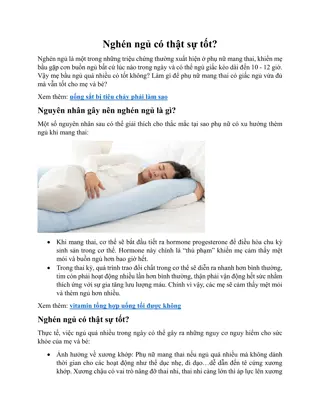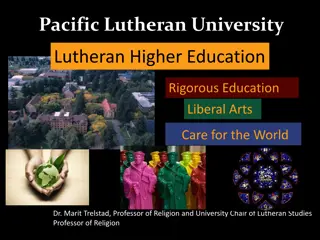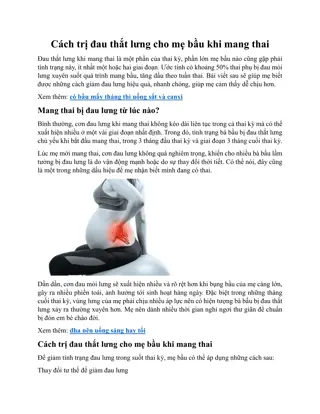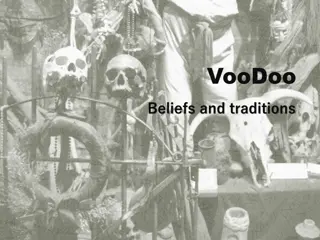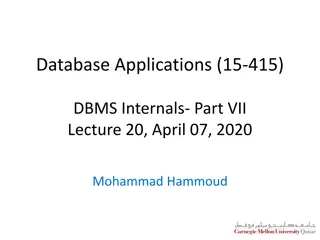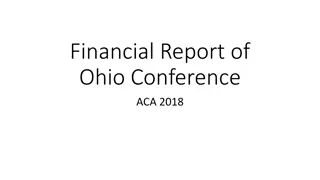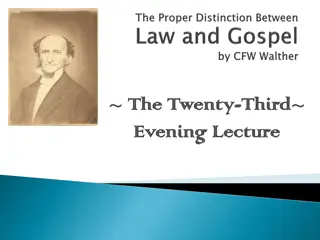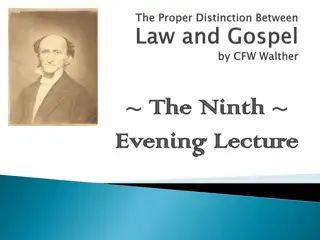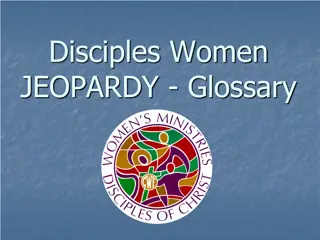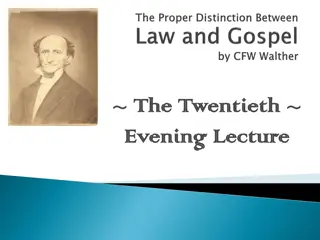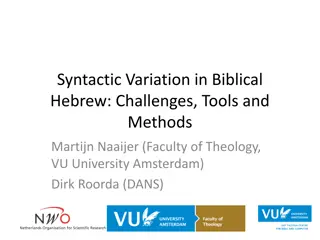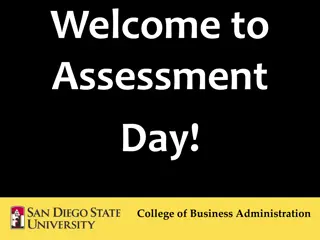
History and Beliefs of the Lutheran Church
Explore the origin, denominational nature, name, and creed of the Lutheran Church, tracing back to the Protestant Reformation led by Martin Luther. Learn about its teachings based on biblical principles and the core creeds it upholds.
Download Presentation

Please find below an Image/Link to download the presentation.
The content on the website is provided AS IS for your information and personal use only. It may not be sold, licensed, or shared on other websites without obtaining consent from the author. If you encounter any issues during the download, it is possible that the publisher has removed the file from their server.
You are allowed to download the files provided on this website for personal or commercial use, subject to the condition that they are used lawfully. All files are the property of their respective owners.
The content on the website is provided AS IS for your information and personal use only. It may not be sold, licensed, or shared on other websites without obtaining consent from the author.
E N D
Presentation Transcript
The Origin of the Church The Lutheran church is the oldest Protestant denomination It did not exist before October 31, 1517 Luther s intention was to reform the Roman Catholic church Luther was protesting the sale of indulgences A ban was pronounced against Luther on May 25, 1521 Luther began a reformed church, with a sizeable following The Bible teaches: The church was founded by Jesus Christ (Matt. 16:18; Acts 20:28) The church was founded upon Jesus Christ (1 Cor. 3:11) The church was established on Pentecost in A.D. 33 in Acts 2 No human institution could be the N.T. church (Matt. 15:13) #1
The Denominational Nature of the Church The Lutheran church teaches: The church has different branches of which the Lutheran church is one Different branches of the church draw different conclusions from the Word of God The Bible teaches: There is only one church, not many (Eph. 4:4; 1:22-23; 2:16) The existence of more than one church is contrary to Christ s plan (John 17) The branches in John 15:1-8 are those in Christ (15:2, 4, 5, 6, 7) One must be in Christ through baptism (Gal. 3:27) and abiding in the words of Christ to be a branch on the vine of Christ The branches are individual Christians/disciples ( you in v. 5, 8) Disciples are those who have been baptized into Christ (Matt. 28:19) Every plant which My heavenly Father has not planted will be uprooted (Matt. 15:13) #2
The Name of the Church Initially, Lutheran was the name applied in derision by Catholic priests Ultimately, Lutheran became the name of the church and the followers The word Luther or Lutheran is not in the Bible The Bible teaches: The church belongs to Christ My church (Matt. 16:18) The church was purchased by Jesus (Acts 20:28) The church was called the church of Christ (Rom. 16:16), the church of God (1 Cor. 1:2), the body of Christ (1 Cor. 12:27), etc. The members of the church were called Christians (Acts 11:26; 26:28; 1 Pet. 4:16), disciples (Acts 6:1; 11:26; 20:7), saints (Rom. 1:7; Phil. 1:1), etc. Christians were never to wear the name of a mere man but of Christ (1 Cor. 1:11-13) There is no other name by which we must be saved (Acts 4:12) We are to do and say everything by the authority of Christ (Col. 3:17) #3
The Creed of the Church The Lutheran church generally holds to NINE different creeds: The Nicene Creed, the Apostles Creed, the Athanasian Creed Luther wrote his own Large Catechism & Small Catechism (1529) Augsburg Confession (1530) The Apology of the Augsburg Confession (1531) The Schmalkald Articles (1537) The Formula of Concord (1577) Compiled in the Book of Concord (1580) The Bible teaches: The Bible is all-sufficient for every good work (2 Tim. 3:16-17) The Bible is all-sufficient for life and godliness (2 Pet. 1:3) The Bible is not to be added to, taken from or modified (Rev. 22:18- 19; Gal. 1:8-9; 2 John 9-11) The Bible is all that saints need to teach & defend the truth (Jude 3) #4
The Organization of the Church The Lutheran church utilizes a Synod organization Lutheran congregations give allegiance to various/different Synods Currently over 40 different Lutheran denominations in North America There are four (or three, or two) major Lutheran denominations in America Each of these major synods/denominations have dozens of regional synods within them which are comprised of the various congregations in that region The Bible teaches: No mention of synods or conferences Congregations of the N.T. church are autonomous, i.e., self-governing Christ has all authority (Matt. 28:18) Every local congregation is subject to the same universal law (1 Cor. 1:10; 4:17; 7:17; 14:33; Col. 4:16) Elders were to be appointed in every congregation (Acts 14:23; Tit. 1:5) Each congregation is independent and there is no authority of an individual or body outside or above the local congregation Overseers of each congregation are permitted oversight only over the single congregation of which they are among (Acts 20:28; 1 Pet. 5:1-3; Heb. 13:17) #5
The Doctrine of Faith Alone The Lutheran church teaches: Justification is by faith alone Luther s interpolation of the word alone into Romans 3:28 Paul s teaching on faith and works is accepted above James teaching The Bible teaches: Faith saves (Eph. 2:8; John 3:16; Rom. 5:1) Works save (Jas. 2:21, 22, 24, 25) Faith alone cannot save (Jas. 2:14, 17, 20, 24, 26 + John 12:42-43) Works of the law of Moses cannot save (Rom. 3:28; Gal. 2:16) Meritorious works of which one may boast cannot save (Ep. 2:8-9) Faith working together with works saves (Jas. 2:22; Gal. 5:6) One must do the will of God to be saved (Matt. 7:21) One must be obedient to the faith (Ro. 1:5; 10:16; 16:26 + Heb. 5:9) We will be judged by our works (Rev. 20:12; Mt. 16:27 + Phi. 2:12-13) #6
The Practice of Infant Baptism The Lutheran church teaches: Infants are proper (and necessary) subjects of baptism Jesus said to bring children to Him, which requires baptism Households were baptized in the N.T., which included infants Baptism has taken the place of circumcision The Bible teaches: Baptism is preceded by hearing the gospel (Acts 18:8) Baptism is preceded by believing the gospel (Mark 16:16; Acts 18:8; 8:12) Baptism is preceded by repenting of personal sin (Acts 2:38; 16:33) Baptism is preceded by confessing faith in Jesus (Acts 8:36-37; Ro. 10:9-10) Infants are incapable of doing these things that precede Bible baptism The purpose of baptism is for the remission of sins (Acts 2:38) Not one single instruction or example of baptizing an infant Circumcision of the flesh was a shadow of true circumcision of the heart with its fleshly pursuits (Col. 2:11; Rom. 2:29) #7
The Doctrine of Total Depravity The Lutheran church teaches: Infants are born in sin, inherited from the father and mother, ultimately from Adam Thus, infants come into the world totally depraved and condemned in the sight of God The Bible teaches: Sin is the result of one s own desires (Jas. 1:13-15) Sin is a personal choice (1 John 3:4; Eph. 2:1-2) Sin is not inherited (Ezek. 18:20) Sin is not inherited through flesh, else Jesus was born in sin (John 1:14; Rom. 8:3; Heb. 4:15) One will be judged for his own sins, not the sins of another (2 Cor. 5:10) #8
The Ten Commandments Are Still Binding #9 The Lutheran church teaches: The moral law sets forth our duties to God and man Moral law is the Ten Commandments and is binding on all men Sunday is the Christian Sabbath The Bible teaches: The Ten Commandments were part of the covenant that God made with Israel at Mt. Sinai (Ex. 34:27-28; Deut. 5:1-2; 4:13; 1 Kgs. 8:9+21) The Ten Commandments (along with all the O.T. law) were abrogated in Christ, being removed at the cross (Rom. 7:1-7; Col. 2:14-17) The Sabbath was the 7th day (Ex. 16:26, 29; 20:8-11; 31:15; 35:2) The Lord s Day was/is the first day of the week (Matt. 28:1-10; John 20:19-29; Acts 20:7; 1 Cor. 16:1-2; Rev. 1:10)
The Doctrine of Consubstantiation #10 The Lutheran church teaches: The true body and blood of Jesus Christ is under the bread and wine With and under the bread and wine are the actual body and blood of Jesus Thus, we receive the body and blood of Christ when we partake The Bible teaches: Christ s body & blood are separate from the emblems (Luke 22:19-20) Partaking of the emblems is a memorial, not a material reenactment (1 Cor. 11:24-25) When Jesus said, This is my body and This is my blood, He was obviously speaking figuratively the same way in which He said, I am the door (John 10:9) and I am the vine (John 15:5)
Believe Jesus is Gods Son John 20:30-31 Repent of your sins and turn to God Acts 17:30 Confess your faith in Jesus Romans 10:9 Be immersed into Christ Mark 16:16 God will forgive all of your sins Acts 2:38 God will add you to His church Acts 2:47 God will register you in heaven Hebrews 12:23 Serve faithfully in His kingdom Matthew 25:23


